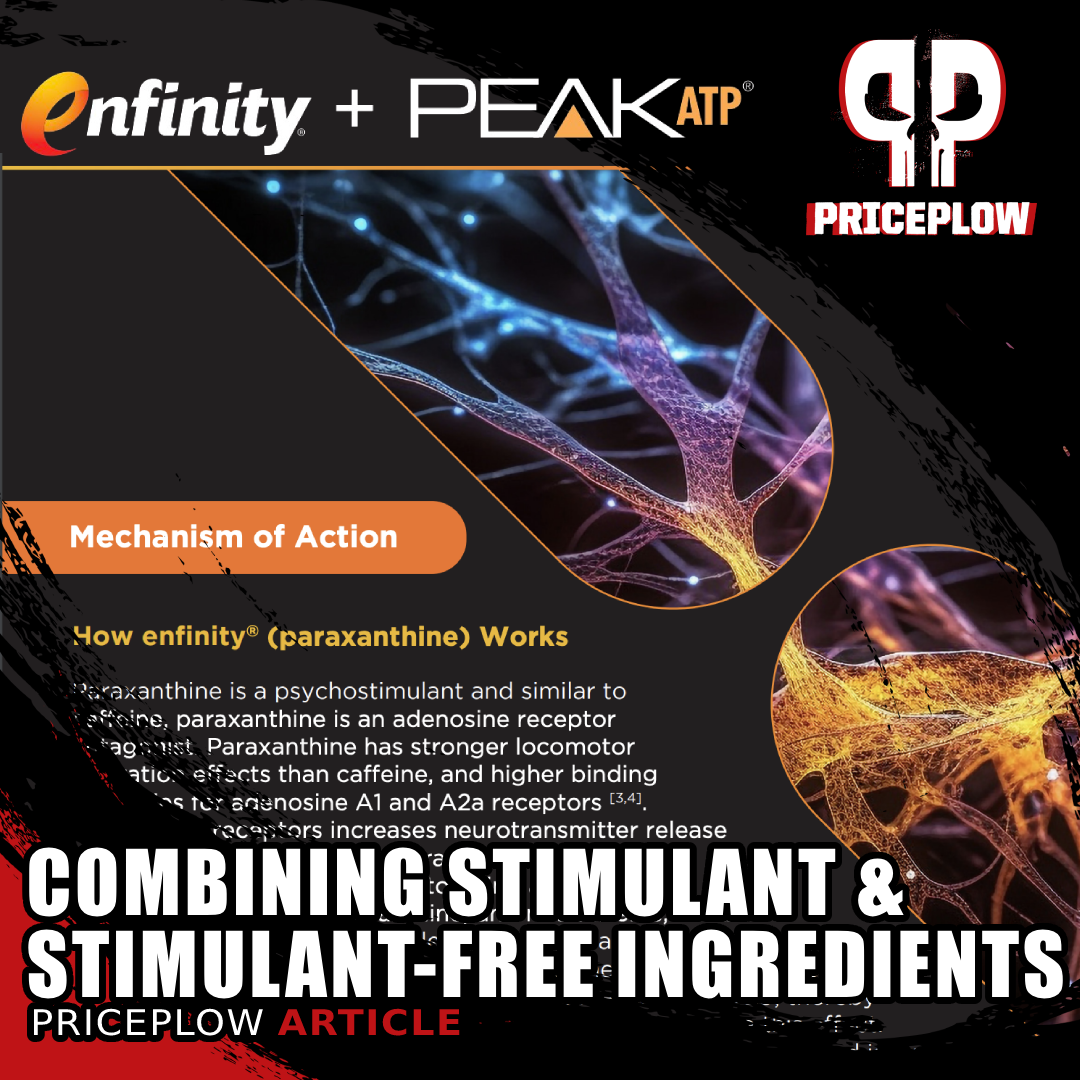
The unique synergy between Peak ATP and enfinity, designed to enhance physical and cognitive performance.
At PricePlow, we've been covering Peak ATP for years, discovering that it does more than just provide energy. Peak ATP supports blood flow, enhances muscular excitability, and aids in post-exercise cognition. Its benefits extend beyond traditional stimulant-free energy supplements, making it a staple for athletes and fitness enthusiasts.
enfinity paraxanthine, on the other hand, is a newer player in the supplement world, gaining recognition as a caffeine alternative. Like caffeine, this stimulant sharpens focus as it boosts energy levels, but it offers more benefits with fewer side effects.
Recent research shows that enfinity increases energy expenditure while reducing heart rate and hunger. Another study demonstrated that it outperforms caffeine in post-exercise cognitive tests. These findings position enfinity as a powerful, multifaceted performance-enhancement ingredient.
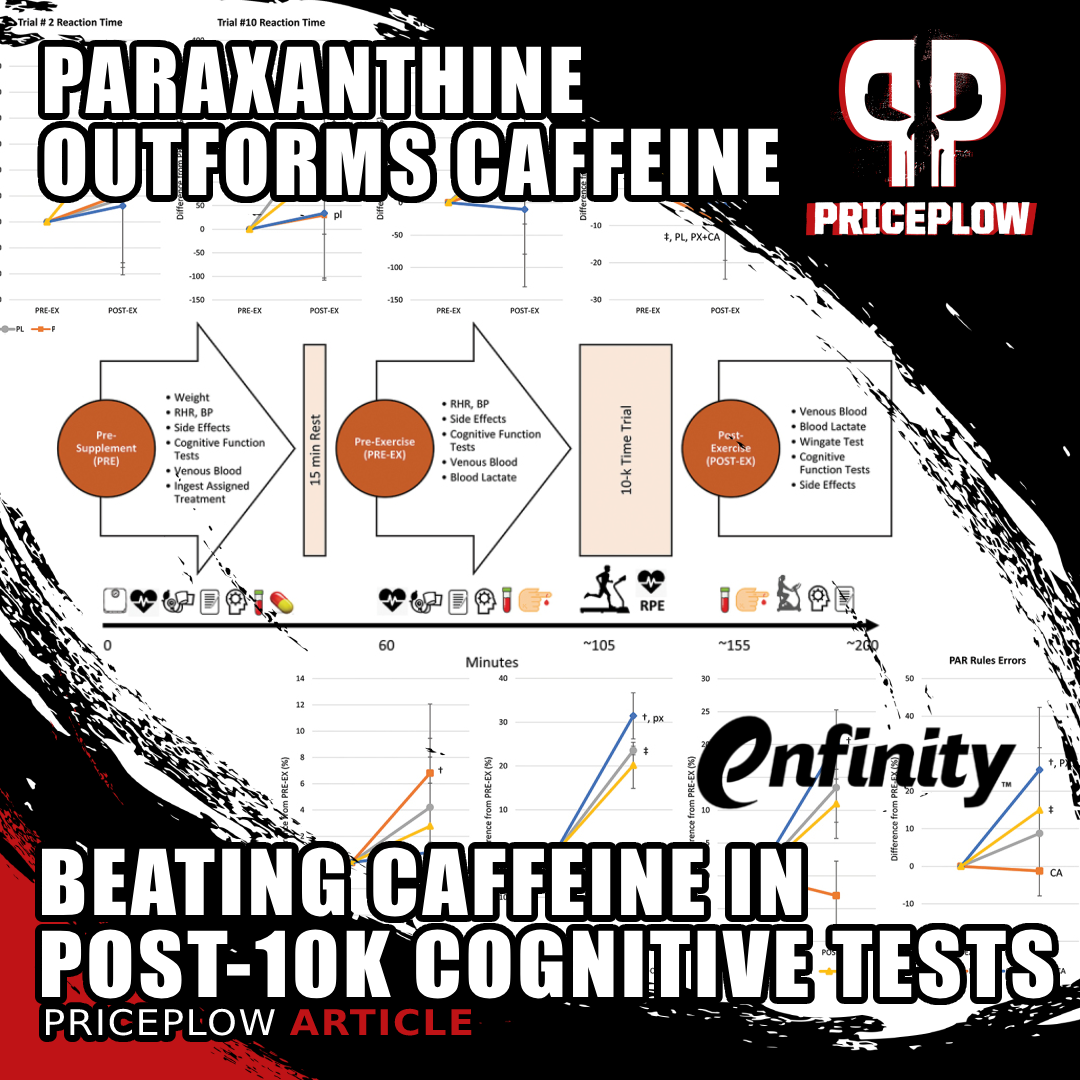
A new study finds paraxanthine (found in enfinity®) outperforms caffeine in boosting cognitive function after a 10k run.[1] Clear thinking under pressure is key to winning, and paraxanthine could be the edge you need.
Previously, we explored the synergy between Peak ATP and creatine, showcasing how these two ingredients work together to amplify physical performance. Now, we shift our focus to another promising combination: Peak ATP and enfinity paraxanthine.
Peak ATP + enfinity: Optimizing Performance and Energy
In this article, we delve into the unique synergy between these two ingredients, exploring how their combined effects can elevate both physical and cognitive performance. By harnessing the distinct advantages of each ingredient, we aim to uncover the full potential of this powerful duo and offer ideas for safely formulating and supplementing them together.
Before getting started, sign up for our TSI Group news alerts to stay informed. TSI is the exclusive distributor of both ingredients and has compiled an impressive body of research on both:
Subscribe to PricePlow's Newsletter and Alerts on These Topics
Understanding the Two Ingredients
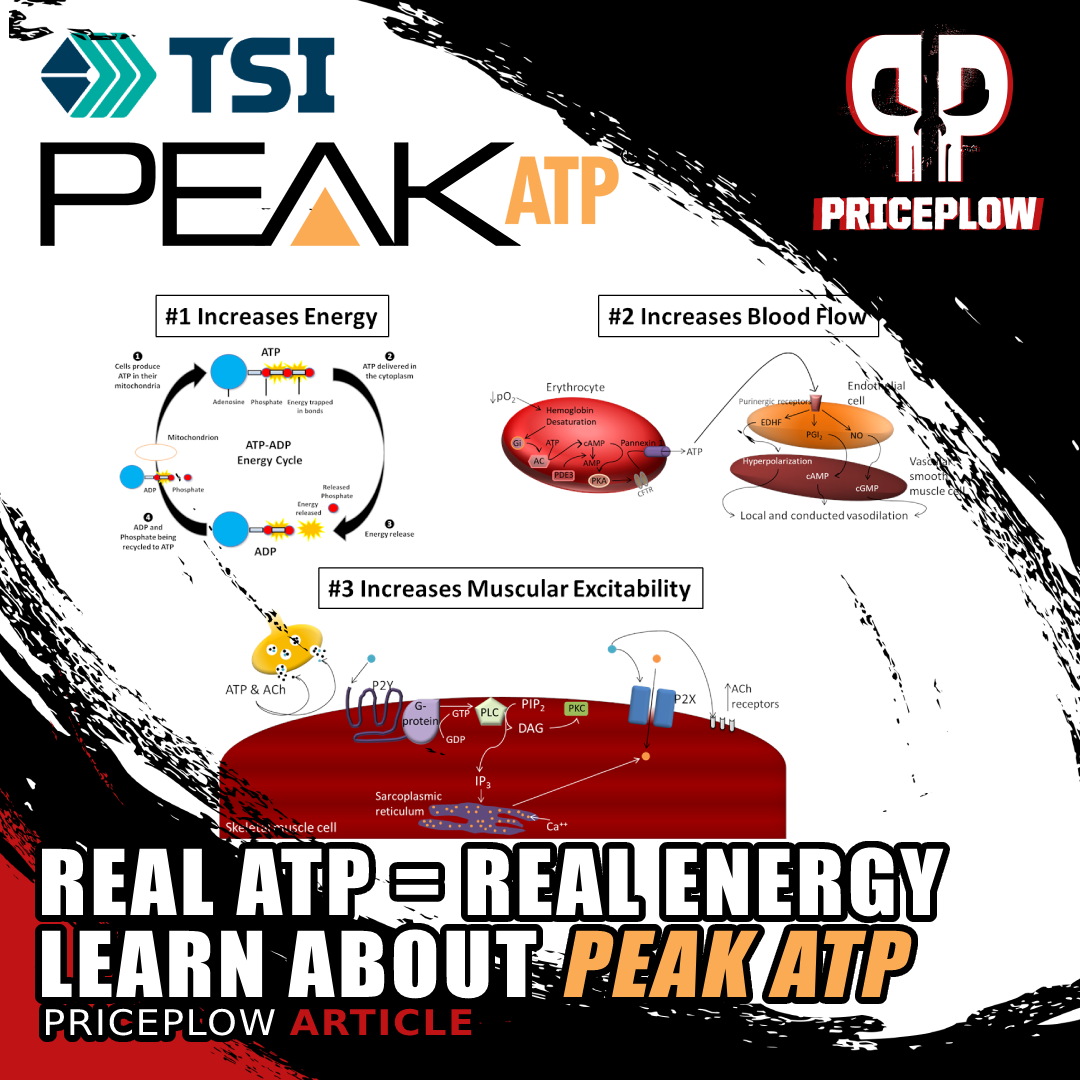
Peak ATP is a patented oral ATP supplement that's been shown to increase blood flow, boost muscle activation through calcium release, and help boost muscle mass, strength, and recovery. This article covers the biochemistry, mechanism, and human research in detail.
Let's examine each ingredient to briefly capture their roles in nutrition and performance:
What is Peak ATP?
ATP is short for adenosine triphosphate, and Peak ATP is a patented and trademarked disodium ATP ingredient.
The bonds in the ATP make it highly-charged, serving as an energy carrier in the body. Some researchers call it "life's energy reservoir".[2] This is why it's dubbed the "energy currency" of our cells -- it's found in every cell in the human body.[3]
Given ATP's broad-ranging impact on cellular energy, Peak ATP has been successfully used for numerous purposes beyond just energy. A research review published in 2021 summarized the findings as follows:[4]
The available literature on ATP disodium when provided in a dose of at least 400 mg approximately 30 min before a workout or 20–30 min before breakfast on non-exercise days provides insight into its potential to reduce fatigue (Purpura et al., 2017,[5] Rathmacher et al., 2012[6]), increase strength and power (Wilson et al., 2013[7]), improve body composition (Hirsch et al., 2017[8], Wilson et al., 2013[7]), maintain muscle health during stress (Long and Zhang, 2014,[9] Wilson et al., 2013[7]), increase recovery and reduce pain (de Freitas et al., 2018[10], Khakh and Burnstock, 2009,[3] Wilson et al., 2013[7]). Additionally, other literature indicates a role for ATP in improving cardiovascular health (Hirsch et al., 2017,[8] Ju et al., 2016,[11] Rossignol et al., 2005[12]).[4]
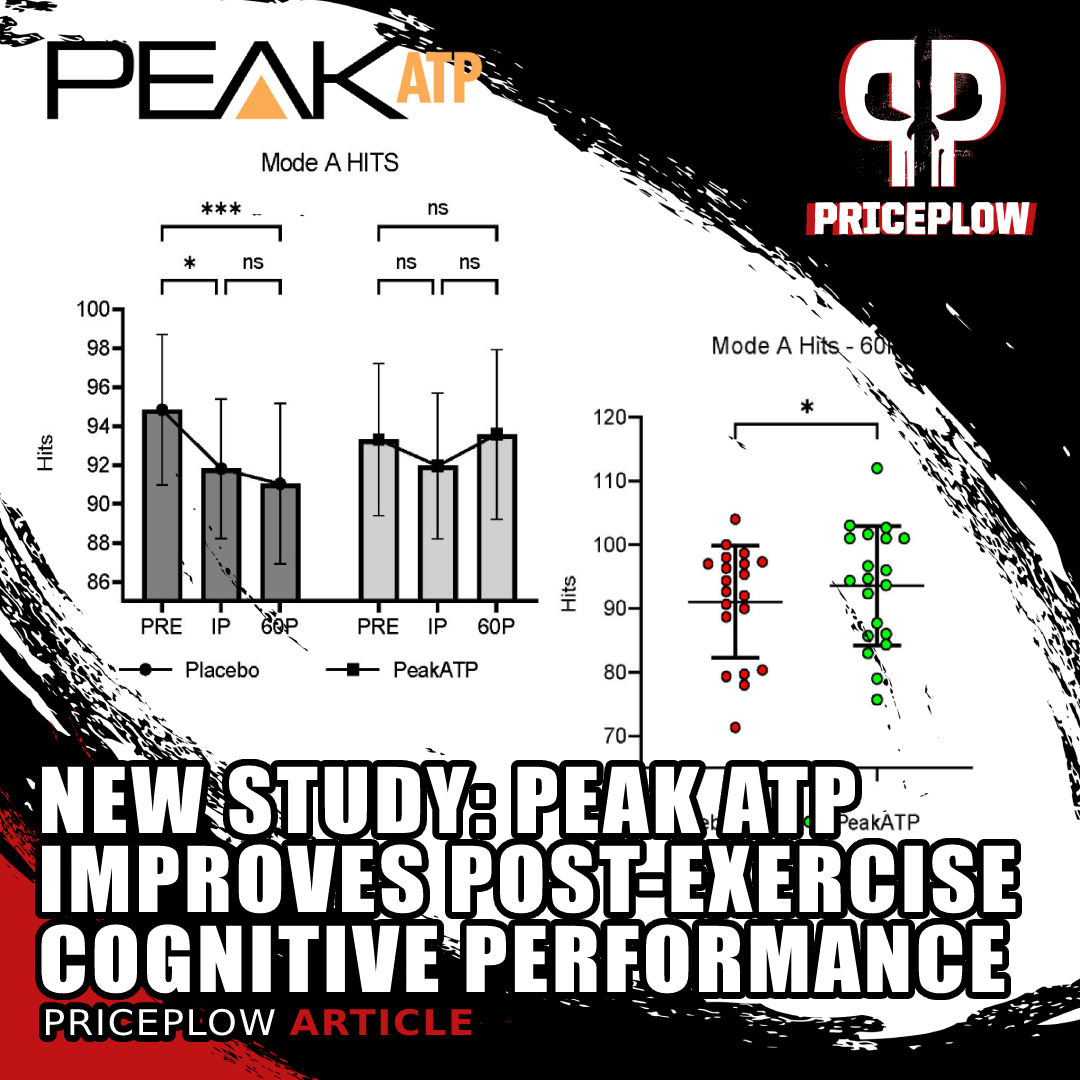
Exercise can create a feeling of mental fatigue by eliciting deficits in attention and processing speed. A study published in 2023 showed that PEAK ATP® helps mitigate deficits in several cognitive tasks following exercise.[11]
Earlier research also showed significantly increased blood flow following exercise with the use of this novel ingredient.[13]
Since then, additional research has supported Peak ATP's ability to mitigate cognitive decline after strenuous exercise.[11] A meta-analysis published in 2024 concluded that 400 milligrams of disodium ATP supplementation enables users to achieve significantly greater gains in maximal strength compared to placebo.[12]
Given the extensive research, Peak ATP should always be considered alongside industry mainstays like betaine, creatine, and HMB when formulating muscle-building and performance-based supplement stacks.
Readers can see our full Peak ATP breakdown for more details, but that's only half of today's equation. With enfinity, we can enhance Peak ATP's stimulant-free power to further boost athletic performance.
What is enfinity?
enfinity is the trademarked name of paraxanthine, the stimulatory ingredient that serves as a caffeine replacement.
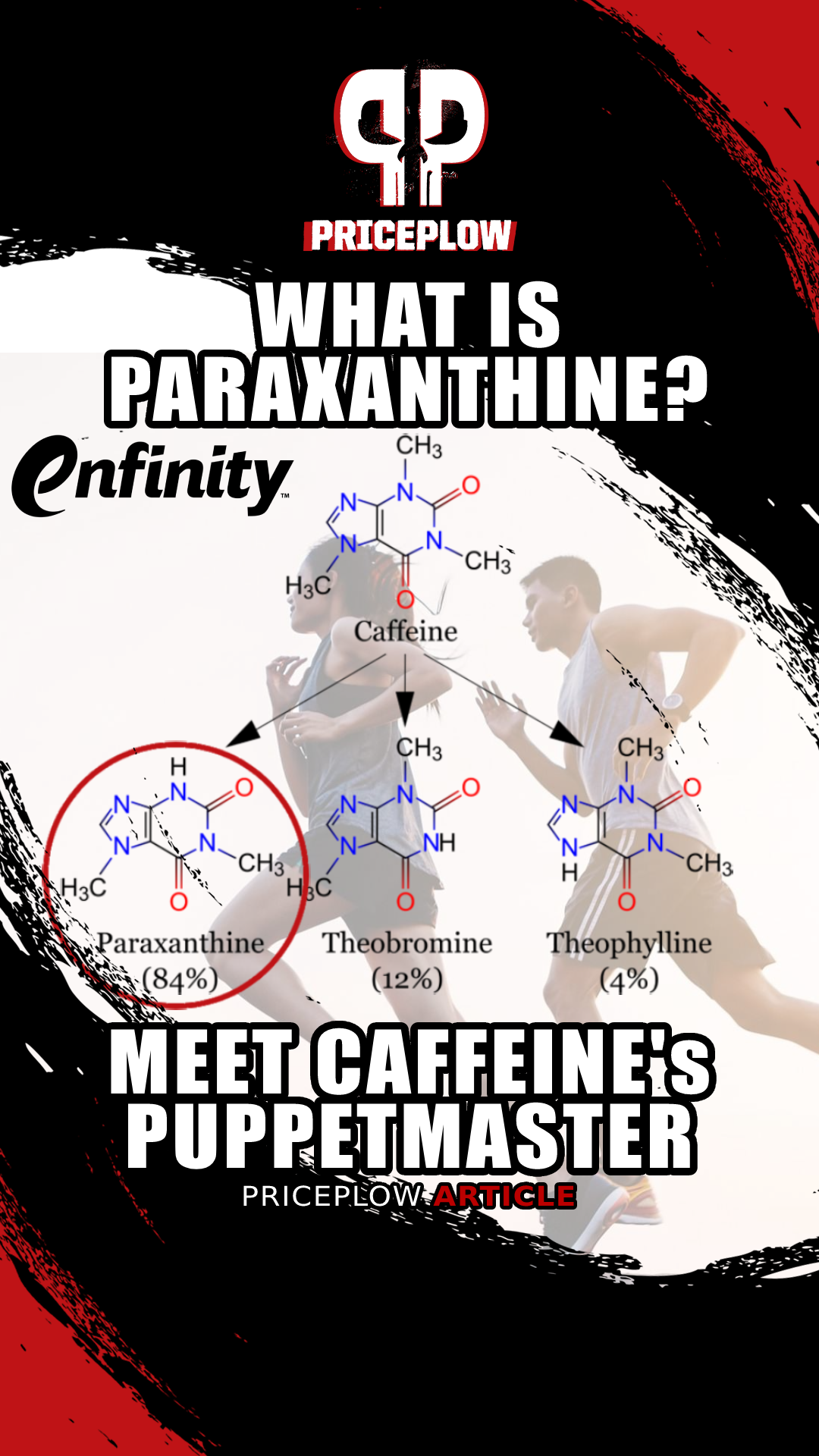
Paraxanthine is the primary metabolite of caffeine, providing most of caffeine's beneficial effects. Now you can take it directly with enfinity!
Paraxanthine is actually the primary metabolite of caffeine, and both function similarly by antagonizing adenosine receptors to promote wakefulness. When you ingest caffeine, roughly 70-80% of it metabolizes into paraxanthine.[14-16] However, two other metabolites, theophylline and theobromine, which have far longer half-lives (~6.2 and 7.2 hours,[14] respectively) and more severe side effect profiles.
Avoiding the pitfalls of caffeine's other metabolites
By side-stepping the two longer-lasting metabolites with paraxanthine, users get the desired effects of caffeine without the drawbacks. Its half-life is 3.1 hours,[14] providing a better-targeted energy solution that doesn't leave theophylline and theobromine circulating in the body into the night.
However, reported half-lives are just the average: Not everyone metabolizes caffeine the same way. There are slow, medium, and fast metabolizers, depending on one's genetics.[17] The situation with caffeine and its other metabolites is even more challenging for slow metabolizers.[18,19] With 46% of the population being fast metabolizers, that means 54% are either slow or intermediate metabolizers![20]
Paraxanthine does it better
Beyond the shorter half-life, paraxanthine has four other major benefits:

Caffeine has three major metabolites, and one of them (paraxanthine) does the heavy lifting. The other two have very long half-lives, which could be interfering with your experience. Image courtesy TSI Group
- Several genes control the breakdown of paraxanthine, while caffeine is only handled by two -- and only one (CYP1A2) controls its breakdown into paraxanthine.[21,22] See the image inset to the right.
- Paraxanthine has higher binding potency for adenosine A1 and A2a receptors.[23,24]
- Paraxanthine can potentiate nitric oxide (NO) signaling through PDE9 inhibition,[25,26] while caffeine cannot.[26]
- Paraxanthine supports dopamine production[25,26] and has been shown to protect dopaminergic neurons.[27]
This translates to better efficacy with greater consistency across individuals.
Now let's take a closer look at how these ingredients can work together.
The Synergistic Benefits of Peak ATP and enfinity
Aside from their shared benefits, there are several ways these two ingredients can work together synergistically:
-
Adenosine Receptor Antagonism and ATP Supplementation
Paraxanthine acts as an adenosine receptor antagonist, reducing the inhibitory effects of adenosine on neurotransmitter release.[28] This supports increased alertness, reduced fatigue, and enhanced cognitive and physical performance.[29]
Exogenous ATP provides a direct source of cellular energy, supporting various functions, including those in the brain and muscles. ATP can be broken down into adenosine, which plays a role in cellular signaling. This breakdown can be modulated by paraxanthine's action on adenosine receptors, balancing adenosine's effects in different tissues.
By using them together, we can supply the body with more energy from Peak ATP while using paraxanthine to limit the effects of its breakdown into adenosine.
-
Enhanced Fatty Acid Oxidation and Immediate Energy Supply
Paraxanthine increases lipolysis and enhances fatty acid oxidation,[30] providing a sustained energy supply from fat stores and increasing energy expenditure (up to 100 calories in 3 hours).[31] This helps maintain energy levels during prolonged physical activities.
Peak ATP offers an immediate source of energy that can be rapidly utilized by cells. This quick energy supply complements the sustained energy from fatty acid oxidation, providing balanced energy availability.
Cognitive Enhancement Through Neurotransmitter Modulation
Paraxanthine enhances the release of neurotransmitters like dopamine and norepinephrine by antagonizing adenosine receptors.[23-27] This leads to improved mood, alertness, and cognitive function.[1,29]
Exogenous ATP supports synaptic function and neurotransmitter release by providing the necessary energy for these processes. Enhanced ATP levels can improve overall brain energy metabolism, complementing paraxanthine's effects on neurotransmitter systems.
Both ingredients have been shown to support improved cognition after strenuous exercise.[11,31]
-
Anti-Inflammatory and Neuroprotective Effects
Paraxanthine possesses anti-inflammatory properties,[32] which can protect cells from stress and damage.
ATP plays a role in cellular signaling pathways that modulate inflammation and protect against cellular damage. One study showed that oral ATP supports muscle maintenance and recovery after surgery.[9]
Together, these ingredients can provide enhanced protection and recovery in tissues subjected to stress or injury.
Dosing and Formulation Strategies
enfinity paraxanthine is clinically-validated at 100-300 milligrams per serving, with a maximum of 400 milligrams per day. Peak ATP is clinically validated at 400 milligrams per day.
This means a brand could simply combine both into one capsule to create an incredible supplement with minimal effort.
However, we like to go further, so we'll propose a basic pre-workout supplement with the following ingredients:
Peak ATP + enfinity Pre-Workout Idea
- Citrulline and/or Nitrosigine: 4g total or more
- Beta-Alanine: 3.2g or more
- Betaine Anhydrous: 2.5g or more
- L-Tyrosine: 1-2g
- Peak ATP: 400mg
- enfinity: 200-300mg
- Cognizin citicoline: 250mg
- Sodium and Potassium
This is a simple yet effective supplement that covers numerous bases without any untested ingredients. The above could also be paired down to create a novel nootropic formula, something we'd love to see on the market.
Alternatively, we would love to see an "afternoon energy muscle builder" to combat the afternoon crash:
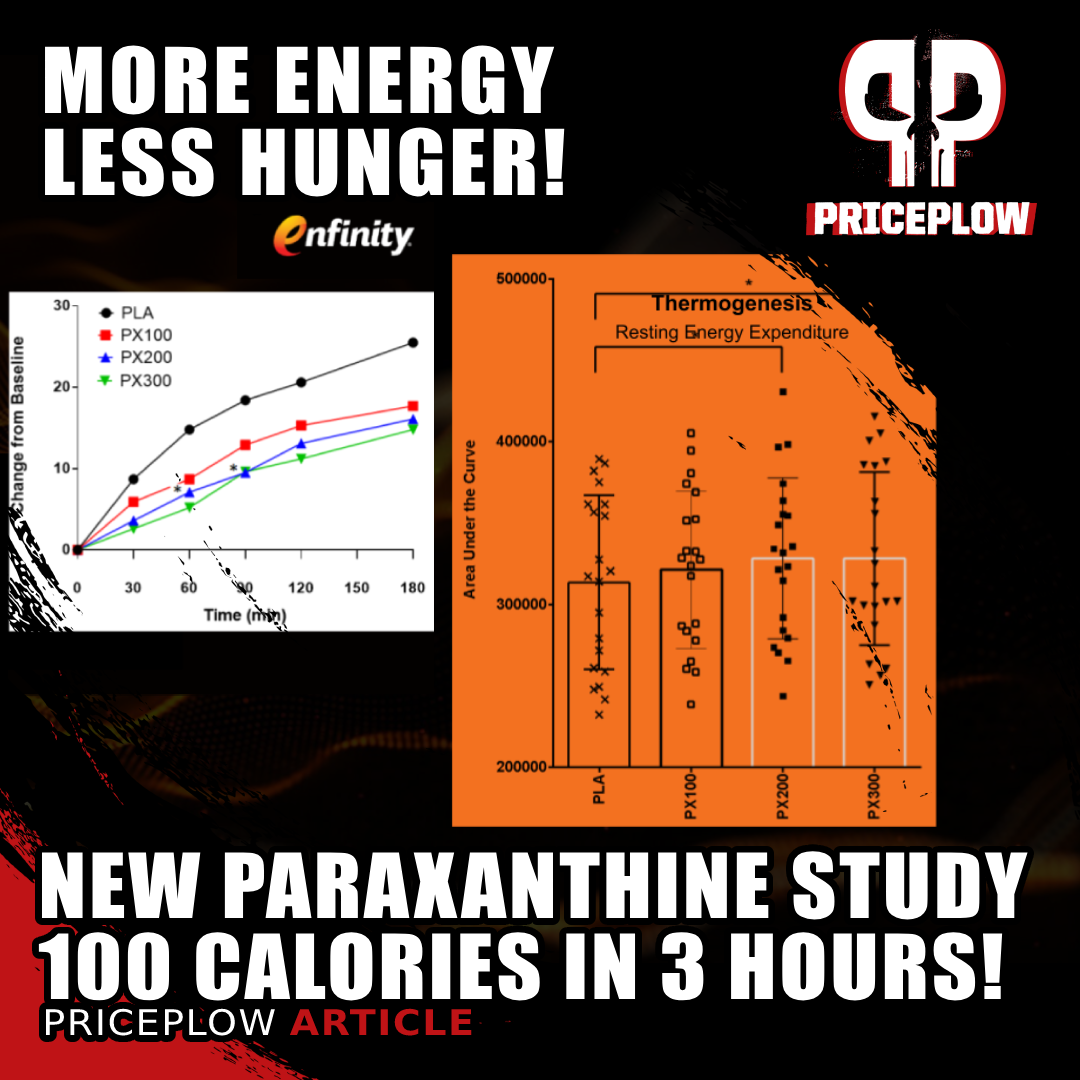
New research data has been published on enfinity (paraxanthine), showing increased energy expenditure compared to placebo (100 calories in 3 hours) -- yet it decreased appetite and heart rate![31]
Peak ATP + enfinity Afternoon Energy Muscle Builder
- Creatine Monohydrate: 3-5g
- myHMB: 1.5-3g
- Betaine Anhydrous: 2.5g
- Peak ATP: 400mg
- GG-Gold (Geranylgeraniol): 300mg
- enfinity: 200mg
- Potassium and Zinc
- Niacin (as nicotinic acid): 20mg
No more afternoon slumps with this one -- this covers several bases to give the body the tools it needs to keep growing. It could also be used in the morning as a coffee replacement.
The MuscleTech Muscle Builder X EuphoriQ Stack: Bringing the Best of Both Worlds
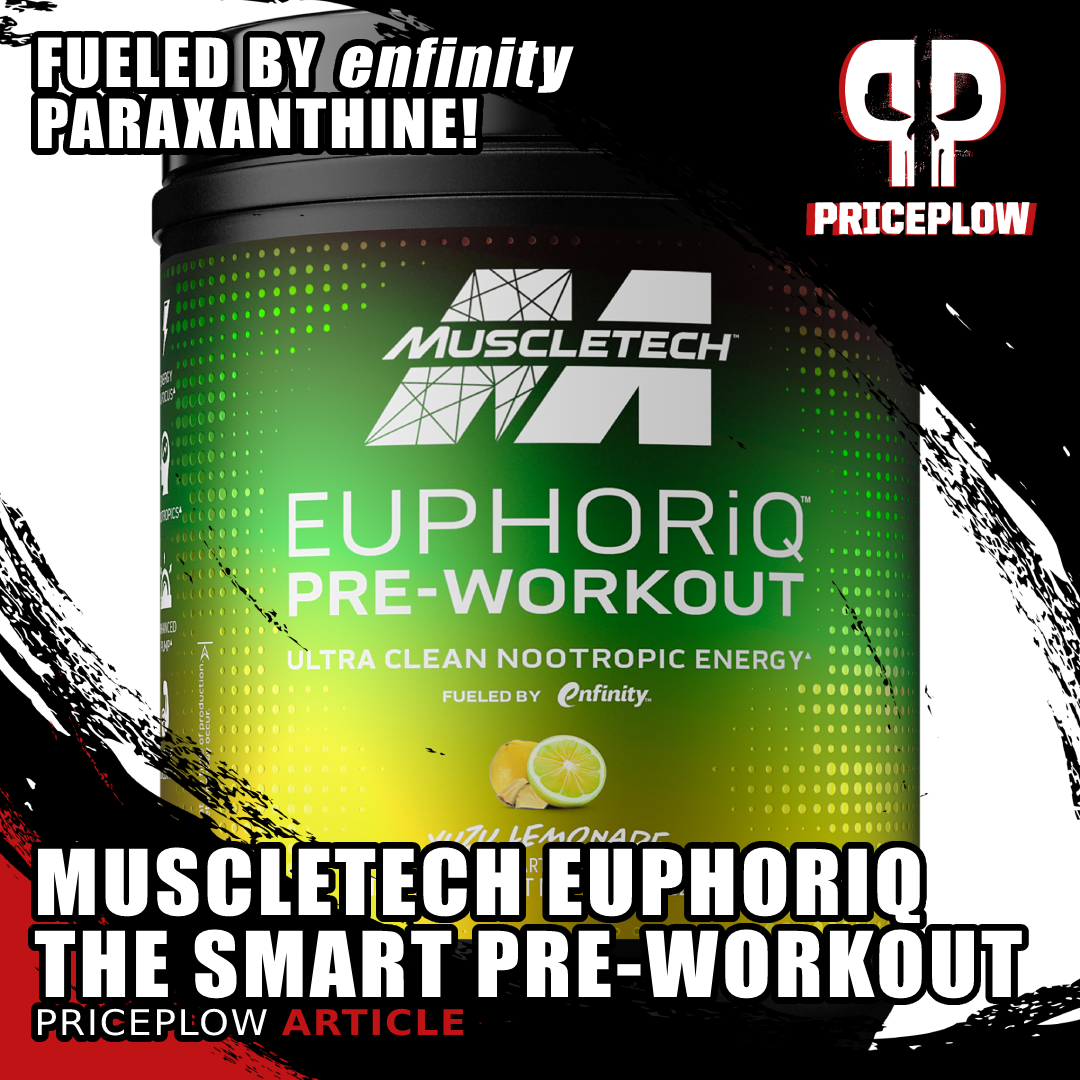
MuscleTech EuphoriQ is the smarter pre-workout supplement - an enfinity-powered nootropic pre-workout supplement that harnesses paraxanthine instead of caffeine!
Looking for a great stack to try both of these incredible ingredients? Look no further than MuscleTech, who was first to launch both ingredients!
For enfinity, the original formula is MuscleTech EuphoriQ, the smart pre-workout supplement developed with enfinity and plenty of other nootropics to get you focused but not overly-stimulated.
For Peak ATP, take a look at the original MuscleTech Muscle Builder, which launched back in 2016 and is still going strong, backed by even more research than when it was launched.
MuscleTech Muscle Builder is standalone Peak ATP, and should be taken daily (with pre-workout if you're training), while EuphoriQ is for workout days... although once you feel the smooth rush of enfinity, you'll want to use it on off-days as well, and that's perfectly fine!
Achieve Peak Energy and Performance
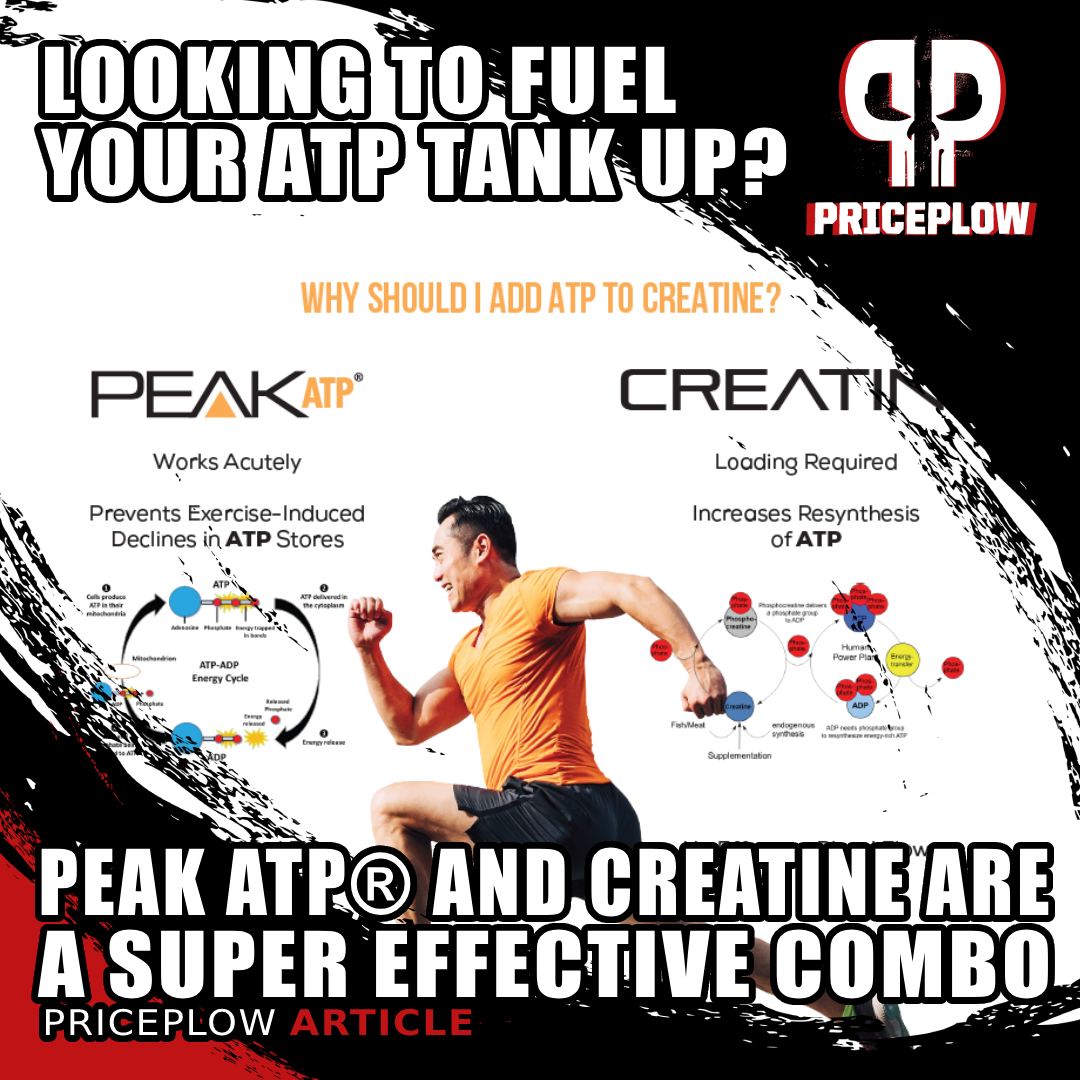
Peak ATP + Creatine make an epic, synergistic duo to boost ATP for improved cellular energy and muscular gains!
Just as we love Peak ATP with creatine, we'd be thrilled to see more well-formulated supplements that combine Peak ATP and enfinity. Their complementary mechanisms of action may enhance their overall effects on energy metabolism, cognitive function, and physical performance.
Paraxanthine's ability to modulate adenosine receptors and enhance fatty acid oxidation complements the immediate energy supply and blood flow provided by exogenous ATP. This combination can lead to improved cellular energy homeostasis, enhanced neurotransmitter function, and better overall cellular protection and performance.
And that means maximizing both mental and physical performance.
Sign up for our TSI News alerts below:

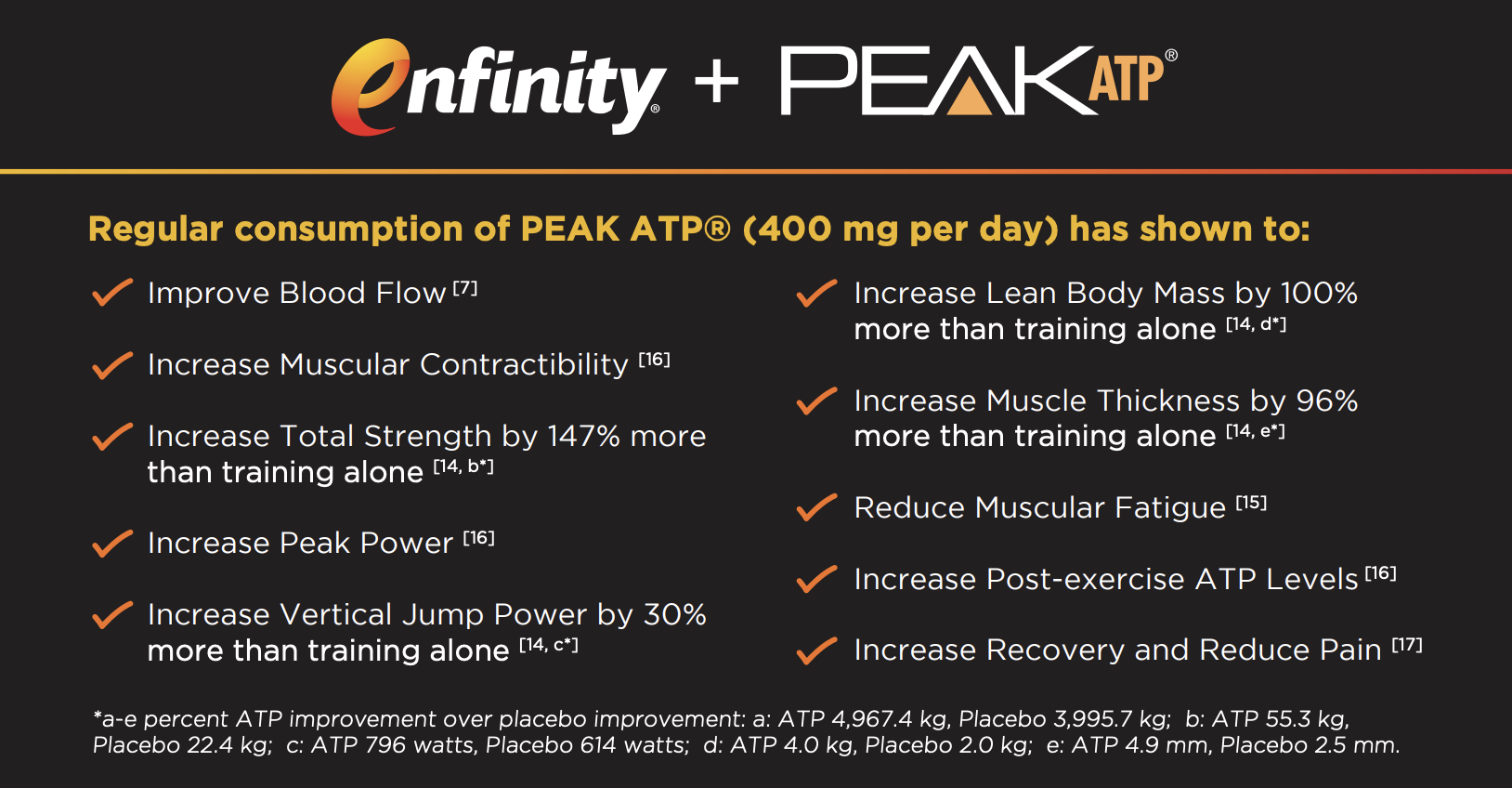
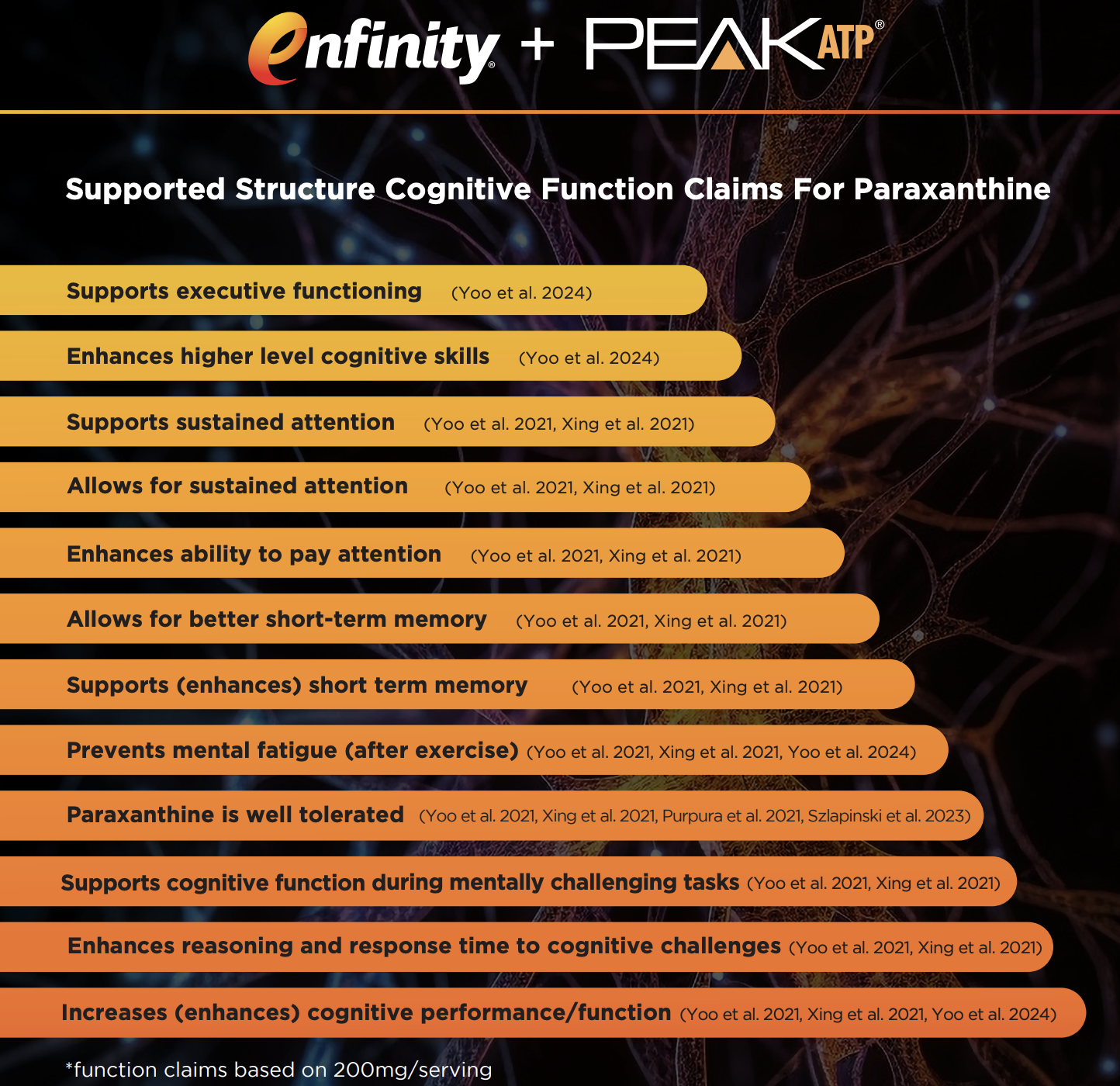


Comments and Discussion (Powered by the PricePlow Forum)